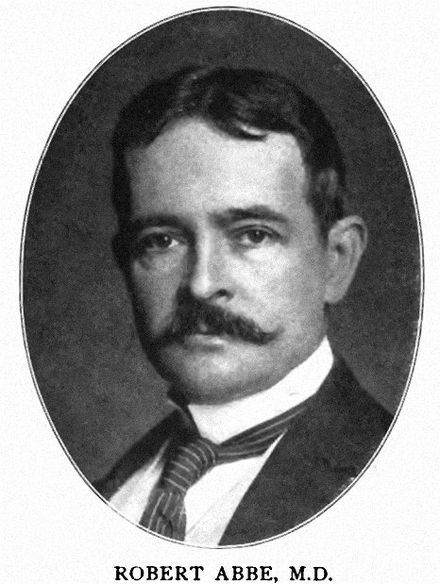Robert Abbe
 Robert Abbe (April 13, 1851 – March 7, 1928) was an American surgeon and pioneer radiologist in New York City. He was born in New York City and educated at the College of the City of New York (S.B., 1871) and Columbia University (M.D., 1874).
Robert Abbe (April 13, 1851 – March 7, 1928) was an American surgeon and pioneer radiologist in New York City. He was born in New York City and educated at the College of the City of New York (S.B., 1871) and Columbia University (M.D., 1874).
In 1888, Robert Abbe in New York as well as W.H. Bennett in London independently performed the first dorsal rhizotomy in patients with ascending neuritis and sciatica, respectively.
The idea of rhizotomy to treat “violent neuralgic pains” was first suggested in 1888 by a New York neurologist named Dr. Charles Dana in a letter to Dr. Robert Abbe.
Dana originally proposed sectioning the posterior spinal roots in patients with intractable athetosis, spastic paralysis, and chronic pain. Abbe soon adopted this posterior rhizotomy procedure and called it Dana's operation.
Abbe's patient, referred to him by Dana, was a 43- year-old male with brachial plexus neuralgia secondary to a shrapnel and stretch injury. He had been treated with nerve stretching, amputation of the arm, and neuroma excision, all without success. Abbe performed C6- C8 posterior spinal rhizotomies in two separate procedures, with good results. Just as significantly, during these procedures, Abbe stimulated the nerve roots to determine their functions; this was the first instance of intraoperative localization and stimulation
This idea was put into action by Dr. Abbe on a select few patients. He found that, indeed, cutting nerves relieved spasticity and the accompanying pain but also resulted in loss of needed sensation and function.
Abbe exposed two inches of dura and with a heavy curved hook I explored the intervertebral foramina, and drew back the sixth nerve . . . outside its point of exit from the dura, but inside the vertebral canal. . . . Upon this root . . . I applied a small metal electrode. . . . The sixth and seventh were then again dragged up from their beds and cut square across just outside the dura. . . . The wound was packed, entirely open, with iodoform gauze. . . . [The patient] bore the operation well, but soon found his old pain seemed much the same. . . . Forty-eight hours after operation I felt that I ought to divide at least one more branch (the eighth). … It looked normal, but I cut it close to the posterior spinal columns…. In two operations, therefore, I had cut the sixth nerve, both roots, outside. The seventh, both roots outside, and also the posterior root inside. The eighth posterior roots only inside the dura. . . . The slit in the dura was now sutured with fine catgut. A little cocaine had been injected along the cut wound . . . and this allowed of painlessly suturing the entire length. . . . Immediate union was thus obtained by second intention. . . . The patient's post-operative course was uneventful, and his neuralgia was cured
One of the cases Abbe reported in 1911 had suffered from infantile hemiplegia and “athetoid paralysis” involving, in particular, the right arm and hand and, to a lesser degree, the right foot.65 “Constant excessive athetoid movements” and pain led sequentially to amputation of the forearm, stretching of the brachial plexus, and then amputation at the shoulder. It was at this point in 1894 that Abbe performed a posterior rhizotomy at C5–C8, and an anterior rhizotomy at C7–C8 to help control the pain and “incessant spasm” . Abbe reported that the man was “discharged [a month later] with very great improvement” and, in particular, that “the constant athetoid spasms had gone.”65 Abbe followed him over the next 16 years until his death in 1910, and noted that although the patient “said he suffered … the old athetoid spasms did not return.” Up to the time of his death, the man “complained moderately and took his morphine. 1)
Abbe's two later papers include various examples of his remarkable skill in spinal surgery, including his performance of the first operation to treat syringomyelia. He incised the dura mater and punctured a syringomyelic cyst, aspirating a small amount of fluid. The patient survived for six months 2).
Abbe was most known as a plastic surgeon, and between 1877 and 1884 he served as a surgeon and professor of surgery at the New York Hospital, St. Luke's Hospital, and the New York Babies Hospital. During this time, he would spend summers travelling, and he amassed a large collection of Native American artifacts and archeological materials.
He is credited with the lip switch flap, which now bares his name. An Italian surgeon named Sabattini described the flap 60 years earlier. Although Sabattini published his technique, it was printed in a book with a limited circulation.
He died of anemia, possibly due to his work handling radium.
Publications
ROBERT ABBE (1851-1928). The surgical treatment of inveterate tic douloureux. New York medical journal 50 (1889): 121-23. Abbe's treatment of tic douloureux consisted of the intracranial excision of a portion of second and third branches from the gasserian ganglion.
ROBERTABBE (1851-1928). Spinal surgery —a report of eight cases. Medical record 38 (1890): 85-92. NSp54.
ROBERT ABBE (1851-1928) & WILLIAM BRADLEY COLEY (1862-1936). Syringo-myelia, operation — exploration of cord — withdrawal of fluid —exhibition of patient. Journal of nervous and mental disease, n.s., 17 (1892): 512-20.